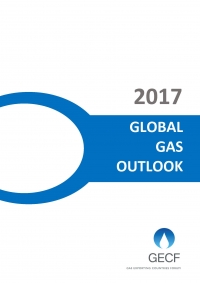QECF: GECF Global Gas Outlook 2017 - eng (pdf) Избранное
EXECUTIVE SUMMARY
Energy markets are liable to experience a significant transformation through to 2040. In 2017-2018, global growth will be supported by several emerging economies that have entered the recovery phase. Commodity markets are rebalancing after a period of increased volatility. Global GDP is expected to grow by 3.7% over the next five years, a slight upswing from the 3.4% seen over the previous five years.
In the long-run, population growth and household wealth are strong drivers for energy demand transformation. The global population will reach 9.2 bn by 2040— a 1.7 billion (bn) person increase from today. This substantial population increase is paired with an 80% forecasted increase in average GDP per capita relative to current levels.
These demographic and socioeconomic trends will catalyse energy demand both directly and via the industrial sector, with the number of households totalling 2.8 bn by 2040 (a 33% increase from 2017). Furthermore, a growing population with more access to wealth will drive vehicle fleet expansion by 60%, with 2 bn cars on the road by 2040.
Energy accessibility will become a top priority in the long-term. Most population and income growth will come from Asia and Africa. These two regions currently have the poorest access to energy and the largest fuel substitution potential. Biomass and waste support 60% of energy consumption in the domestic sector in developing Asia and 80% in Africa, compared to less than 6% in developed countries.
World energy demand is projected to grow by 1.1% per annum, rising 29% between 2017 and 2040, from 13.8 to 17.8 gigatonne of oil equivalent (Gtoe). By 2040, fossil fuels are expected to meet 75% of the world’s energy demand.
The share of natural gas in the global energy mix will increase from 22% in 2016 to 26% in 2040. Coal will see a 7% decrease (from 27% to 20%), to be gradually replaced by natural gas, renewables (17%) and nuclear (6%). Concurrently, the share of oil in the global energy mix will decrease by 3%, to 29% in 2040.
Consumers of natural gas benefit from its economic and environmental advantages, namely low prices, ample reserves, and relatively low emissions. Therefore, demand for natural gas is expected to grow during the period under review in this Outlook, as customers seek an energy source that supports economic development and addresses environmental concerns.
Global gas consumption will increase by 53% between 2017 and 2040. This growth will be led by non-OECD Asia, followed by the Middle East and Africa. Natural gas will become the fastest growing fossil fuel, with an annual growth rate of 1.8%, reaching 5395 billion cubic metres (bcm) in 2040.
Demand for gas in the power sector increased from 692 bcm in 2000 to 1280 bcm in 2016, with an annual average growth rate of 3.9%. This represents 36% of the gas consumed in all energy sectors in 2016. The GECF expects that consumption in the power sector will continue to increase by an average growth rate of 2.5% per annum, reaching 2329 bcm in 2040.
Global electricity demand has been increasing since 2000 and is projected to peak at 41235 terawatt hours (TWh) in 2040. Demand for electricity grew at an average rate of 3% per annum between 2000 and 2016, and is expected to grow at an annual rate of 2.2% between 2017 and 2040. Urbanisation and the associated increase in residential energy demand, coupled with industrial expansion, particularly in developing economies such as China and India, are the main drivers propelling electricity demand.
Rapidly expanding production and trade of pipeline gas and, especially, liquefied natural gas (LNG) has been observed in recent years. In 2016, global trade of LNG totalled 257.7 million tonnes (MT) — a 15 MT increase from the previous year. This is the largest incremental growth in LNG volume since the 2011 Fukushima Daiichi nuclear accident. In this Outlook, this boom in LNG trade is expected to continue, with liquefaction facilities coming online in the US and Australia at increasingly higher rates. The second wave of expansion will come primarily from Qatar and other GECF Members in approximately 2025, as well as from the US. Significant developments in pipeline infrastructure are also taking place in the CIS region, expanding pipeline capacity that will drive exports to China and Europe through the Power of Siberia and the Southern Gas Corridor, respectively.
Unconventional natural gas resources will play an increasingly greater role in global supply. This Outlook projects that the share of unconventional gas in total gas production will rise from approximately 16% today, to more than 30% in 2040.
A low-carbon future is emerging as a key concern for the international community, especially with the adoption of the Paris Agreement in December 2015. This Agreement has galvanised the energy community, with more than 190 countries pledging to mitigate their greenhouse gas (GHG) emissions through Intended Nationally Determined Contributions (INDCs).
Paving the way to a low carbon future must take into account the compatibility of CO2 mitigation with sustainable development, including its economic, social, and environmental dimensions.
***
The GECF Secretariat will continue to support GECF Members both in dialogue in the international community and with analytical support, such as that contained in this GECF Global Gas Outlook 2017.
Дополнительная информация
- Серия: Международные организации / GECF / GECF Global Gas Outlook 2040
- Год: 2017
- Источник: Gas Exporting Countries Forum (GECF)
- QECF: GECF Global Gas Outlook 2017 - eng (pdf) (1413 Скачиваний)


































